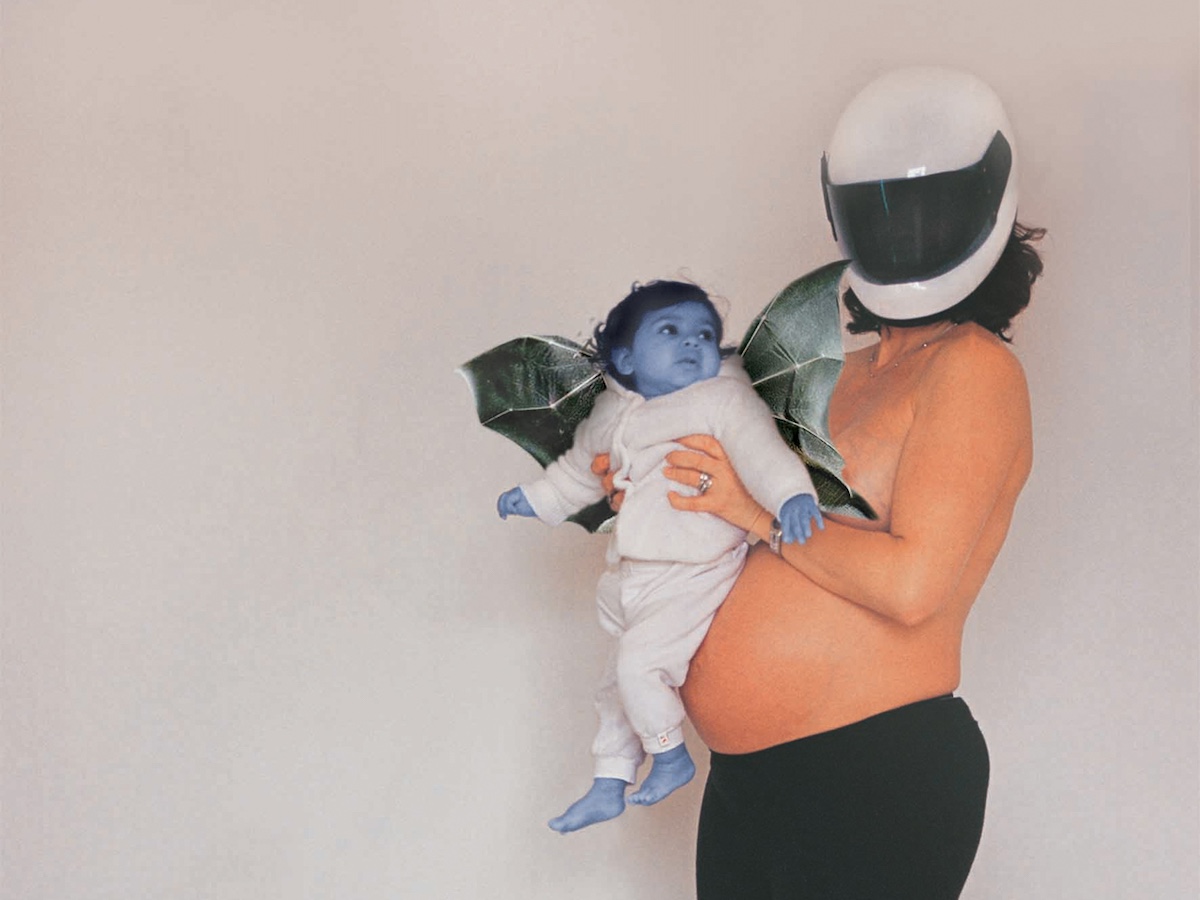
on archival Hahnemuhle Photo Rag
paper, 45 x 30 inches (114.3 x 76.2 cm) (© Bharti Kher; image courtesy the artist
and Hauser & Wirth)
When writer and curator Hettie Judah invited Su Richardson to participate in an exhibition called Acts of Creation: On Art and Motherhood last year, the artist wasn’t too pleased. Richardson, who had contributed to the pioneering feminist exhibition Portrait of a Housewife in 1977, was initially “quite upset,” per Judah, about being asked to join yet another group show about motherhood half a century later. “In another 50 years,” Richardson asked, “will we be doing it again?”
Richardson’s frustration was justified: discussions about the plight — and dearth — of artist-mothers have seemingly gone in circles for decades. We already know that women’s disproportionate domestic obligations can frustrate or altogether crush their creative aspirations (see: Tillie Olsen’s 1965 essay “Silences” and Linda Nochlin’s landmark 1971 “Why Have There Been No Great Women Artists?”). Yet even as the sociopolitical landscape shifts underfoot, we keep asking the same question without resolution: Can a mother be an artist? As a result, the prevailing message for women is still that parenthood and creativity are incompatible — just ask the ambivalent artist-mothers that anchor a recent spate of novels, as well as works of nonfiction published in the last two years like Julie Phillips’s The Baby on the Fire Escape, Catherine Ricketts’s The Artist Mother, Begoña Gómez Urzaiz’s The Abandoners, and JoAnna Novak’s Contradiction Days.
Judah has long sought to complicate this conversation. Her 2022 polemic How Not to Exclude Artist Mothers (and Other Parents) argued that the art world has much to gain by better accommodating the needs of artists with children. Her second book on the topic attempts something even more ambitious: to establish a canon of women artists who have made muses out of motherhood. A sweeping survey of art by and about mothers, Acts of Creation accompanies the eponymous touring exhibition in which Richardson ultimately chose to participate. Judah recounts the Richardson anecdote early in the book to acknowledge that her subject matter is not groundbreaking; the book and exhibition, she writes, “consciously tread in the paths of earlier enterprises in the hope of keeping them present in memory and introducing artists to the work of their forebears.”

Acts of Creation includes more than 100 works — paintings, sculptures, photographs, films, performances, and more — spanning thousands of years and multiple continents. The book has a broader scope than its namesake exhibition, highlighting not only contemporary artists but also depictions of motherhood as far back as the Upper Paleolithic. From the Madonna to Roman Charity to the “fallen woman” stereotype, this comprehensive accounting of mothers in art history helps contextualize recent works by artist-mothers, many of which reference longstanding tropes.
Judah’s overview, condensed into precious few pages, often feels cursory, and as the book progresses, it becomes clear that she’s more interested in taxonomy than analysis; the artworks, which are loosely organized by theme (“creation,” “maintenance,” “loss”) are rarely put in conversation with one another. But what Acts of Creation lacks in connective tissue, it makes up for in brilliant curation. The book is most exhilarating when it traces the surprisingly long lineage of mothers whose art was influenced by childrearing. If, as Rachel Cusk writes, “the experience of motherhood loses nearly everything in its translation to the outside world,” then the works assembled here confront and subvert that ineffability.

The book opens with a haunting full-page reproduction of “The Painter,” Marlene Dumas’s 1994 portrait of her daughter, which represents what Judah calls “the monstrous child” — an alternative vision of British critic Cyril Connolly’s now-cliched “pram in the hall,” which he described as the “somber enemy of good art.” She goes on to examine work by Impressionist painter Berthe Morisot, who depicted her own mothering, as well as the maternal labor of wet nurses; abstract sculptor Senga Nengudi, whose sand-filled pantyhose boldly evokes the pregnant body; Carmen Winant, whose images of women in labor and mothers nursing asserted the artistic value of taboo physical realities; painter Alice Neel and photographer Rineke Dijkstra, whose respective portraits of expectant and postpartum women individualized the experience of motherhood; and many more. (The aforementioned artists, it should be noted, are all covered at length in Ricketts’s The Artist Mother.)
Along with institutional and material support, artist-mothers need role models, and Judah resoundingly proves that like-minded women have always found ways to create amid constraint. One of her earliest examples is English painter Mary Beale, whose exquisite 1666 “Self-Portrait” shows the artist alongside an unfinished artwork of her two sons — an explicit nod to her identity as a mother. Yet much of Beale’s work, and that of countless other artist-mothers, has been forgotten or erased, leaving us with what Phillips, in The Baby on the Fire Escape, calls a “blank spot on the map where mothering and creativity converge.”
“It seems to me,” Judah opines, “that the same works are made over and over again because part of our art history remains unwritten.” She recalls that when Judy Chicago began her Birth Project series in the early 1980s, she had never encountered Frida Kahlo’s harrowing 1931 painting “My Birth” — so she was “under the impression no woman artist had properly addressed the subject before.” Fifty years after Kahlo, Chicago was, to borrow Richardson’s phrase, “doing it again.” Acts of Creation joins a growing body of work that summons the past and surveys the present so that artist-mothers might enter new territory, where they can transcend the same old self-negating questions — if mothers can be artists, if motherhood can inspire good art — and focus instead on their own self-determination.



Acts of Creation: On Art and Motherhood (2024) by Hettie Judah is published by Thames & Hudson and is available online and through independent booksellers.

